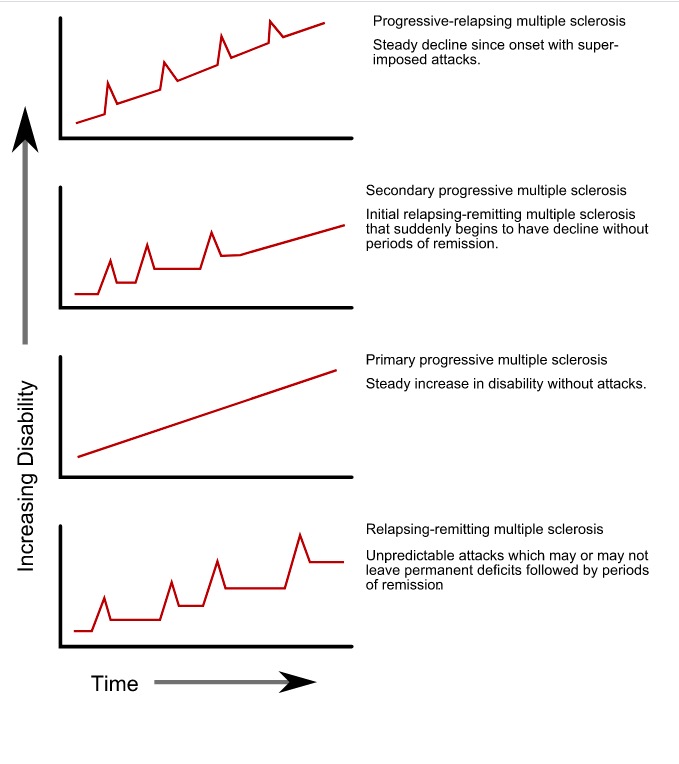Playlist
Show Playlist
Hide Playlist
Case: 21-year-old Woman with Blurry Vision
-
Slides Multiple Sclerosis Inflammatory Disorders of the CNS .pdf
-
Download Lecture Overview
00:02 In this talk, we're going to review multiple sclerosis, which is our classic recurrent T cell-mediated CNS immune disorder. 00:11 So let's start with a case. 00:13 This is a 21 year old woman, who presents to your clinic today as a new patient visit for blurry vision. 00:19 This began two weeks ago when she first noted that her right eye was sore. 00:25 Several days later, she noted that her right eye began to become blurry, and within a week later, it had progressed to the point that she couldn't see nearly anything out of it. 00:34 At this point, she went to an optometrist who center for an MRI of the brain. 00:39 After her MRI, she was referred to you in Neurology based on those findings. 00:44 She reports that about three months ago, she had the onset of numbness and tingling in the left leg and arm, which slowly progressed over the course of a couple of weeks. 00:55 She states that initially started in her distal foot and slowly ascended to the level of her knee with numbness in her arm, to the level of her elbow. 01:04 Both regions seem to be continuing to progress at this point in time. 01:09 So there's a few interesting features and important features of this case that you want to hone in on. 01:15 The first is the timeline of onset. 01:18 The symptoms in her eye began over a course of two weeks. 01:21 That's a sub-acute onset condition and should raise possibility for an inflammatory condition. 01:28 The second is the evolution over time. 01:30 They progressed gradually and rapidly, as we would expect for an immune attack. 01:38 And then there's multiple localizations. 01:40 We have the new symptoms in the right eye that sound monocular, the sounds like a prechiasmatic lesion in the right eye. 01:47 And then the spinal cord related symptoms with asymmetric numbness and tingling in the leg and arm, sparing the face without brainstem or cranial nerve symptoms suggestive of a spinal cord lesion. 01:58 It's that separation in with multiple locations is concerning for an autoimmune condition like MS. 02:08 The patient underwent MRI of the brain. 02:10 And here we're looking at the coronal flare, and we can see a increased signal within the right optic nerve, which you can see with the arrow. 02:19 And you can compare that to the left optic nerve which is smaller and not as bright as on the normal side. 02:26 The patient had visual field testing, which were intact a confrontation. 02:30 Fundoscopic examination was without optic disc pallor or edema. 02:34 There's not something we can see within the optic nerve. 02:37 And her visual acuity was 20/20 in the left eye, and 20/70 in the right eye with red desaturation in the right eye. 02:44 So color desaturation. 02:47 So what's the most likely diagnosis in this patient? Is it MS? NMO or neuromyelitis optica? Clinically isolated syndrome? Or is this an ischemic optic neuropathy? Well, this doesn't sound like a clinically isolated syndrome. 03:02 The patients presenting with new vision complaints in the right eye and a prior episode of what sounds like a spinalcord syndrome. 03:09 And that multiple presentations makes us concern for recurrent syndrome, like MS, NMO, antiMOG disease, or some other similar condition. 03:20 This doesn't sound like NMO. 03:22 This patient has a presentation of the unilateral visual field defect and we often see bilateral optic neuritis, which would raise a stronger suspicion for NMO. 03:33 NMO would be a consideration in this patient, but it's not the most likely diagnosis based on the information that we have. 03:40 This doesn't sound like an ischemic optic neuropathy. 03:43 The time course and onset of this patient's presentation is more suggestive of an inflammatory condition as opposed to ischemic optic neuropathy. 03:51 And so multiple sclerosis is the right answer here. 03:54 That is the most likely diagnosis and requires additional workup but the clinical features are suggestive of a diagnosis of MS.
About the Lecture
The lecture Case: 21-year-old Woman with Blurry Vision by Roy Strowd, MD is from the course Multiple Sclerosis (MS) and Inflammatory Disorders of the CNS.
Included Quiz Questions
Which statement is TRUE regarding the localization of multiple sclerosis?
- It may affect multiple locations in the CNS.
- It may affect multiple peripheral nerves.
- It typically affects only one peripheral nerve.
- It usually manifests solely in the spinal cord.
Which is most likely to support the diagnosis of multiple sclerosis?
- An enhanced signal on FLAIR in multiple locations in the CNS
- Acute bilateral vision loss that is described as a "curtain being lowered in front of the eyes"
- A single episode of optic neuritis
- Bilateral optic neuritis
Customer reviews
5,0 of 5 stars
| 5 Stars |
|
5 |
| 4 Stars |
|
0 |
| 3 Stars |
|
0 |
| 2 Stars |
|
0 |
| 1 Star |
|
0 |




